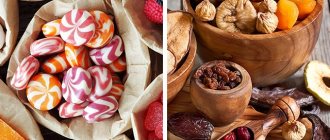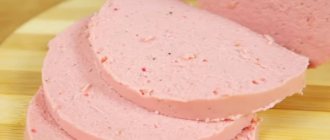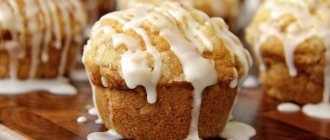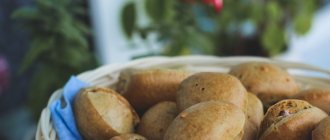Properties of baking powder
How much does baking powder cost (average price for 1 g)?
Moscow and Moscow region.
2 r.
What needs to be done to make the dough porous and fluffy, and the finished flour product tender and airy? Of course, add dough leavening agents, which are chemical substances that have the ability not only to give the dough a porous structure and increase its volume, but also to significantly speed up the baking process. Usually the dough is loosened using yeast, soda, potash, ammonium carbonate and directly baking powder or baking powder. Alcoholic drinks such as rum, cognac or alcohol are used much less frequently for these purposes.
The main active substance when baking cakes, cakes, pies and cookies is yeast, but when the recipe does not provide for their use, soda or baking powder is used. Soda itself is not a leavening agent - it begins to act only when it interacts with acid or vinegar. But in the case of baking powder, it is not required. Traditionally, one kilogram of wheat flour requires two teaspoons of baking soda or five teaspoons of baking powder.
Often both of these leavening agents are present in recipes. Their presence is due to the fact that the components in the baking powder are selected in such a way that they react without residue. However, there are also products that have a strong acidic reaction - it is for them that soda is needed.
How much baking powder is in 1 sachet?
Recipes do not always use a teaspoon to indicate the volume of baking soda or baking powder. Amounts of ingredients may be given in grams or in packets, as is the case with baking powder. It is usually sold in small packages of 10-15 g. On the back of the bag it is clearly indicated how much flour it is designed for.
To convert the volume of a bag of baking powder into teaspoons, you need to know that in 1 tsp. contains 5 g of baking powder. Accordingly, a package weighing 10 g contains 2 tablespoons of powder, which equals 1 tsp. soda How much baking powder you need to make a cake or cookies should be determined by the volume of flour. As a rule, 1 sachet of baking powder is designed for 0.5 kg of dry mixture.
Composition of baking powder
If you look at the packaging, you can get acquainted with the composition of the baking powder: citric acid, baking soda and wheat flour (or starch). When using it, you do not need to dissolve it, but just add it to the flour. The reaction begins exclusively during the baking process, so the finished dough can be left for a while rather than immediately put in the oven.
Quite often, many housewives, looking at the composition of the baking powder, wonder whether this product is harmful and in what doses it can be consumed without fear for health.
How to make baked goods using homemade baking powder
By the way, now is the time to remember tea. I wanted to bake a cupcake in the microwave to go with it. I like this pastry because it is very easy to prepare and bakes very quickly.
Today's topic began with the fact that there was no baking powder in the house for baking. I took the recipe from my mother and prepared the baking powder in 5 minutes. Now you can conduct a culinary experiment and prepare baked goods.
To prepare a cupcake in the microwave you need:
- 1 egg
- 5 tbsp. kefir
- 3.5 tbsp. Sahara
- a pinch of vanilla
- 5 tbsp. flour
- 1/2 tsp. baking powder
Mix all ingredients in a container. Add homemade baking powder at the very end to the flour. It is always mixed with flour. You can even mix it separately and then add it to other ingredients. Quickly knead the batter and pour it into the mug in which we will bake our pastries.
As you can see, the dough immediately became covered with small bubbles. The reaction has started, so bake this dough immediately after preparing the dough. The reaction is faster in this test because it uses kefir. In an acidic environment, soda begins to react faster. If the dough is kneaded with milk, then this reaction will occur more slowly.
Place the mug in the microwave for 5 minutes at 700 W. After the beep, the cake is ready. During cooking, it rose to the ceiling of the microwave. But, as always happens, after baking it immediately sank back down.
As you can see, it fit perfectly. It is soft and porous. And it is also very tasty. You can find recipes for other microwave muffins in the section.
The takeaway from this cooking experiment is that homemade baking powder works. Tomorrow I want to cook with it, the recipe for which I have already shared with you.
Now you know how to make baking powder at home. Use it, prepare delicious pastries, and I invite you to my website for recipes. Here you will find a lot of interesting things.
PS If your acquaintances and friends ask you how to make baking powder from soda, recommend this recipe to them.
You can try baking powder by making the curd bagels from this video.
How many grams per serving of product:
- 10 grams = 1 teaspoon
- 30 grams = 1 tablespoon
- 160 grams = 1 glass
- 12 grams = 1 package.
Calorie content of baking powder: 79 kcal
Its energy value (in the ratio of fats, proteins and carbohydrates):
- Fats – 0.00 g
- Proteins – 0.105 g
- Carbohydrates – 19.60 g (78 kcal)
- Product - energy ratio: b-1%/w -%/y -99%
Baking powder - Ingredients
You always need to add something to the dough so that it is fluffy and porous, and the finished baked goods are tender and airy. And this something is a dough leavening agent, which is capable of making the dough quick and fluffy. Baking powder consists of chemicals.
Often the dough is loosened using soda, yeast, ammonium carbonate, potash, and also baking powder. Soda itself is not considered a leavening agent, because it only acts in interaction with fermented milk products or vinegar. Per kilogram of dough, according to tradition, 2 teaspoons of soda (five tablespoons of baking powder) are required.
Yeast is the active ingredient when baking cakes, crusts and pies, but if the recipe does not call for its use, then you need to add soda or baking powder.
Composition of baking powder
The composition of the baking powder product is always indicated on the packaging: baking soda, citric acid, wheat flour (starch). When using it, do not dissolve it, but immediately add flour and mix well. The reaction begins during baking, so you can not immediately put it in the oven, but leave the dough for a while, it will not spoil.
Harm of baking powder
Many people wonder about the dangers of baking powder. What concerns does baking powder bring with its composition? Experts say ambiguously: in modern packets of baking powder they add sodium dihydrogen phosphate, sodium dihydrogen pyrophosphate, sodium bicarbonate and others.
Doctors warn that frequent use of phosphates can lead to an imbalance in the body between phosphorus and calcium.
When purchasing baking powder, carefully consider its composition - the safest is: soda, citric acid and flour.
Video on how to make baking powder at home
Most types of baked goods made from unleavened dough are prepared using baking powder. Its task is to make the products light, fluffy, and crumbly. And sponge cake, shortbread pies and cookies without the use of this component will turn out dense, tasteless and unappetizing. Our grandmothers, in order to loosen the dough, added soda to it, after quenching it with vinegar. This method is simple and economical, but it has a drawback: when extinguishing soda, it is very difficult to calculate the optimal amount of vinegar, sometimes it does not reach all the grains, as a result, pies and cakes acquire a soda taste, which can negate the pleasure of eating dessert. Modern housewives prefer to purchase bags of baking powder in the store, which can loosen the dough without imparting an off-flavor to the baked goods. Such powders are inexpensive, but situations when they are not at hand at the very moment when the housewife decided to bake a cake or cookies happen quite often. Then the cook is faced with a dilemma: abandon the idea or make baking powder at home. It is advisable to take the second route, since the process of preparing baking powder is simple, and almost every kitchen will have the ingredients that may be required for this.
Harm of baking powder
Experts answer this question ambiguously. Recently, dough leavening agents have begun to be produced quite widely, which contain some not particularly useful substances: sodium dihydrogen phosphate, sodium bicarbonate, sodium dihydrogen pyrophosphate and others. The names alone are worth it! Doctors warn that excessive use of phosphates leads to an imbalance in the human body between calcium and phosphorus. Therefore, it is worth thinking about the real harm of baking powder and modern components in its composition.
In addition, the starch used in such mixtures is often modified, which in itself, of course, is not particularly healthy. Therefore, when purchasing dough baking powder, always pay attention to their composition - the most harmless will be a mixture of flour, soda and citric acid.
Making your own baking powder
Baking powder is a mixture of soda and citric acid, selected in such a ratio that when heated they react completely, without residue. To make baking powder at home, you need to combine soda, citric acid and a neutral component, which is most often flour or potato starch.
The proportions for mixing the ingredients are 5:3:12, that is, you need to take 5 g of soda, 3 g of acid and 12 g of flour. The result is 20 g of ready-made baking powder, which is no different from store-bought baking powder. It is recommended to store it in a glass jar with a lid to limit air access to the ingredients.
So, from our article you learned how much is in 1 tsp. soda and baking powder. This ratio (proportion) is 1:2. That is, in 1 tsp. soda contains 2 tsp. baking powder. The presented nutritional supplements are considered interchangeable, except for recipes where one of the required ingredients is honey.
Used in recipes:
Key lime pie Chocolate cake Marble cake Potato dough sticks Cereal pancakes Cheese buns Date pecan pie Cornmeal pie
| Navigation: All recipes |
- Geography test Test of knowledge of the countries of the world by flags, location, area, rivers, mountains, seas, capitals, cities, population, currencies
- IQ test free online When taking the test, you cannot use paper, a calculator, a pen, a cheat sheet, the Internet or tips from a friend
- Human visual memory test Determine the level of your visual memory by answering the questions of our free online psychological test
- Prophet Test You must concentrate and try to guess where the ace is hidden!
- Road signs of the Russian Federation The test performs exclusively a self-study function and serves as a useful preparation tool for passing the real exam!
- Borders and neighboring countries Take a test to test your knowledge of neighboring countries. Find out which countries border the country where you are planning to go on vacation
- State flags Do you know the flag of your country? And the flag of the country where are you going to go on vacation?
- Free IQ test IQ test lasts 30 minutes and contains 40 simple questions!
- Test: Continents The database contains detailed information about 199 countries of the world!
Free games online · Eng · CZ Hry · Games online for free · Icon on your Web · Visitors' book · RoboStav Copyright (c) 2020 by Topglobus.ru. All rights reserved!
What is baking powder and how is it different from yeast?
Baking powder is a powder that can be used to create airy, melt-in-your-mouth baked goods. This product contains baking soda, citric acid, starch or flour. When mixed in the dough, baking soda and citric acid enter into a chemical reaction, which releases carbon dioxide, which expands the dough with bubbles, which gives it fluffiness.
This is because the process of whipping egg whites creates tiny air bubbles that add volume and lightness. This method is most often used in souffles, pancakes, meringues and some types of cakes. This may be a good option if you don't have baking powder or baking soda on hand.
The amount you should use depends on the recipe. For example, an angel food cake may require up to 12 egg whites, while a batch of pancakes may only require two or three. To ensure your egg whites are perfectly light and fluffy, beat them on low speed until they become foamy, then increase the speed until the beaten eggs form soft peaks.
Baking powder makes baked goods more airy and appetizing
Baking powder is easy to make at home.
To do this, you will need the same products: citric acid, soda, flour or starch. All ingredients must be dry. If citric acid is in crystals, it must be crushed to powder in a mortar or rolled in a plastic bag with a rolling pin. The ratio for 20 grams of baking powder: soda 5 grams, citric acid 3 grams, starch or flour 12 grams. It is difficult to weigh such an amount, so I give the ratio in teaspoons: 5:3.75:12. Pour it all into a clean, dry jar without stirring. Between the layers of active ingredients there should be a layer of filler - starch or flour. This way, improvised baking powder is stored longer without losing its properties at all. You can use homemade baking powder in the same way as factory-made baking powder; it will not differ in quality.
How to choose the best stock
Gently fold remaining ingredients into beaten egg whites.
To choose the best baking substitute, it is important to keep in mind the flavor profile of the finished baked goods. For example, vinegar can add a sharp, sour flavor and is probably best as a substitute for baking powder in recipes that call for minimal quantities. On the other hand, molasses have a very sweet taste and complement sweet desserts better than savory breads. Additionally, you may need to adjust other ingredients in your recipe based on what you decide to use as a substitute.
Yeast also has the same leavening properties. But, unlike baking powder, it is a biological leavening agent consisting of living microorganisms. Under favorable conditions, they begin to reproduce, releasing carbon dioxide. But this process takes time.
With flour
- Time: 10 minutes.
- Number of servings: per 1 kg of flour.
- Calorie content of the dish: 79 kcal per 100 g.
- Purpose: for breakfast.
- Cuisine: European.
- Difficulty: easy.
We suggest you read: What speed can a horse develop?
The easiest way to make baking powder at home is to mix the necessary ingredients with flour. This option was often used by housewives in Soviet times, when baking powder, like a lot of other products, was considered scarce. If someone managed to get a couple of bright bags, then their price significantly exceeded the cost of homemade baking powder.
Ingredients:
- flour – 12 g;
- citric acid – 4 g;
- soda – 8 g.
Cooking method:
- Sift flour into a deep bowl.
- Mix it with the rest of the dry ingredients.
- The resulting mixture is poured into a dry jar with a volume of at least 250 ml.
- Store in a dry and dark place.
Baking powder for dough with starch
- potato starch – 36 g;
- soda – 30 g;
- citric acid – 12 g.
Cooking method:
- After measuring the required amount of each product, mix them together.
- Sift the resulting mixture through a fine sieve 2-3 times. This manipulation will allow you to achieve an even distribution of all components.
- Pour the baking powder into a dry jar and close it tightly.
To prepare baked goods for 1 kg of flour you will need to take 30-40 g of the resulting baking powder. One teaspoon contains about 8 g of this product. This means that for 1 kg of flour you will need 4-5 teaspoons of the prepared mixture.
The dough is light and airy and will rise well. And when it’s baked, it will be incredibly fluffy. Cakes made from this dough are evenly and deeply soaked. And in combination with cream, they give birth to an incredible miracle, generously giving everyone bright emotions and almost childish delight. Making such a dessert is the ultimate dream. But who is the “culprit” that such dough turns out? Baking powder! It is this seemingly insignificant component, like the magic wand of Cinderella’s godmother, that turns the whipped dough into an air-filled culinary work.
How to make it yourself at home?
Making baking powder for dough with your own hands at home is easy and profitable for many reasons:
- the dough with homemade baking powder turns out several times more fluffy;
- store-bought often contains preservatives and food additives, while homemade baking powder is a natural product;
- the price of homemade baking powder is several times less.
To prepare baking powder, you will need a kitchen scale, as they make it easier to measure the required amount of ingredients. An empty container is placed on the scales, into which 48 g of wheat flour is first added, then 20 g of baking soda, and finally 12 g of citric acid. At this stage, you can already use baking powder, but it is advisable to additionally pass the mixture through a coffee grinder or grind it in a blender to obtain a powder with a uniform structure.
We invite you to familiarize yourself with what remontant strawberries are
Those who do not have kitchen scales at home can use a recipe in which the volume of ingredients is converted into familiar portions. You can make homemade baking powder by mixing 12 tsp. flour, 3.75 tsp. citric acid and 5 tsp. soda
Features of dough preparation
- Homemade baking powder should contain only dry ingredients. Not the slightest bit of liquid should be allowed in, otherwise carbon dioxide will begin to be produced. Accordingly, it is better to use citric acid in powder form;
- If you need to prepare a large volume of product for repeated use, it is recommended not to stir the entire composition. It can only be stored in the refrigerator;
- For one-time use, just mix one teaspoon of each product;
- The amount of soda also directly depends on the main recipe. If a pie or other culinary product contains chocolate, honey and nuts, then its amount must be halved;
- On the contrary, you can increase the amount of soda if the dish is prepared from kefir, yogurt and any whey;
- If the cake contains citrus components, then soda alone can act as a leavening agent. In this case, there is no need to extinguish it first.
What is baking powder?
Yes, it seems like just about every recipe under the sun calls for suckers. However, there are egg alternatives that you can use to take the cooking stress out of the equation. The next time you're knee deep in a baking project that calls for eggs, try these substitutes.
Another baking powder option
If all you have is sweetened applesauce, then simply reduce the amount of sugar in the recipe. Note that this may introduce a mild banana flavor into whatever you're cooking, which can be a good thing. Baking powder is often mixed with baking soda, which contains only sodium bicarbonate and no acid component.










